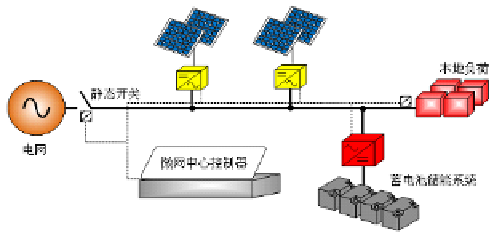Information Technology Reference
In-Depth Information
uncertainties are from the PV power systems, which inject variable active power
according to the atmosphere condition, and also from the loads that vary quasi-
randomly. Different strategies for maintaining the active power balance have been
proposed, based on the energy storage, dump load control, or a combination of both
and load shedding.
Fig. 1.
The structure of microgrid under study
3
MG Control Strategy under Grid-Connected Mode
When the MG works in grid-connected mode, the frequency and the voltage of the
microgrid are maintained within a tight range by the main grid. In this section, we
detail the MG control design under grid-connected mode.
3.1
Normal Model of a PV Array
To control the MG with integration of PV power as shown in Fig 1, to model the PV
array is necessary. A PV array is composed of several PV modules connected in
series-parallel to produce desired voltage and current. Usually, more PV cells are
needed to form the series-parallel PV array. The relationship of the output voltage and
current of one PV cell can be represented as follows:
q
UIR
+
s
(1)
II
=−
I
exp
(
UIR
+ −−
)
1
s
ph
s
AKT
sh
where
I
is the output current of PV cell;
U
is the output voltage of PV cell;
I
ph
is the
photocurrent;
I
s
is the reverse saturation current of diode;
q
is the electronic charge
(1.6×10
-19
C);
K
is Boltzmann's constant (1.38×10
-23
J/K);
T
is Junction temperature;
A
is the diode ideality factor;
R
s
is series resister;
R
sh
is shunt resister.
Due to the large value of shunt resistance
R
sh
, the last term in (1) is often omitted,
the short-circuit current and photocurrent are considered to be equal (
I
sc
≈
I
ph
) , and
when the PV cell is on open circuit, the output current is zero, so output current of a
PV cell can be approximated as :
q
(2)
II
=
1exp
−
(
UIRU
+ −
)
s
sc
oc
AKT















Search WWH ::

Custom Search